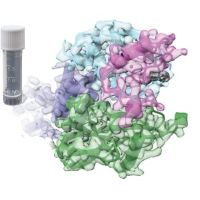Specification
| Description | Recombinant protein from the full-length sequence of Homo sapiens acyl-CoA synthetase long chain family member 5 (ACSL5), transcript variant 2 (NM_203379). |
| Organism | Homo sapiens (Human) |
| Expression Host | Human Cells |
| Tag Info | His or DYKDDDDK. Please contact us if you need further information or require specific designed tag. |
| Purity | Greater than 90% by SDS-PAGE gel |
| Uniprot ID | Q9ULC5 |
| Entry Name | ACSL5_HUMAN |
| Gene Names | ACSL5 ACS5 FACL5 UNQ633/PRO1250 |
| Alternative Gene Names | ACS5 FACL5 |
| Alternative Protein Names | Long-chain-fatty-acid--CoA ligase 5 (EC 6.2.1.3) (Arachidonate--CoA ligase) (EC 6.2.1.15) (Long-chain acyl-CoA synthetase 5) (LACS 5) |
| Application | Antigens, Western, ELISA and other in vitro binding or in vivo functional assays, and protein-protein interaction studies; For research & development use only! |
| Buffer | Purified protein formulated in a sterile solution of PBS buffer, pH7.2, without any preservatives |
| Endotoxin | Endotoxin level is < 0.1 ng/µg of protein (<1EU /µg) |
| Length | 683 |
| Molecular Weight(Da) | 75991 |
| Protein Sequence | (The sequence of expressed protein may have some variation from the sequence shown below. Please contact us for the exact sequence.) MLFIFNFLFSPLPTPALICILTFGAAIFLWLITRPQPVLPLLDLNNQSVGIEGGARKGVSQKNNDLTSCCFSDAKTMYEVFQRGLAVSDNGPCLGYRKPNQPYRWLSYKQVSDRAEYLGSCLLHKGYKSSPDQFVGIFAQNRPEWIISELACYTYSMVAVPLYDTLGPEAIVHIVNKADIAMVICDTPQKALVLIGNVEKGFTPSLKVIILMDPFDDDLKQRGEKSGIEILSLYDAENLGKEHFRKPVPPSPEDLSVICFTSGTTGDPKGAMITHQNIVSNAAAFLKCVEHAYEPTPDDVAISYLPLAHMFERIVQAVVYSCGARVGFFQGDIRLLADDMKTLKPTLFPAVPRLLNRIYDKVQNEAKTPLKKFLLKLAVSSKFKELQKGIIRHDSFWDKLIFAKIQDSLGGRVRVIVTGAAPMSTSVMTFFRAAMGCQVYEAYGQTECTGGCTFTLPGDWTSGHVGVPLACNYVKLEDVADMNYFTVNNEGEVCIKGTNVFKGYLKDPEKTQEALDSDGWLHTGDIGRWLPNGTLKIIDRKKNIFKLAQGEYIAPEKIENIYNRSQPVLQIFVHGESLRSSLVGVVVPDTDVLPSFAAKLGVKGSFEELCQNQVVREAILEDLQKIGKESGLKTFEQVKAIFLHPEPFSIENGLLTPTLKAKRGELSKYFRTQIDSLYEHIQD |
Background
| Function | FUNCTION: Catalyzes the conversion of long-chain fatty acids to their active form acyl-CoAs for both synthesis of cellular lipids, and degradation via beta-oxidation (PubMed:17681178, PubMed:24269233, PubMed:22633490). ACSL5 may activate fatty acids from exogenous sources for the synthesis of triacylglycerol destined for intracellular storage (By similarity). Utilizes a wide range of saturated fatty acids with a preference for C16-C18 unsaturated fatty acids (By similarity). It was suggested that it may also stimulate fatty acid oxidation (By similarity). At the villus tip of the crypt-villus axis of the small intestine may sensitize epithelial cells to apoptosis specifically triggered by the death ligand TRAIL. May have a role in the survival of glioma cells. {ECO:0000250, ECO:0000269|PubMed:17681178, ECO:0000269|PubMed:18806831, ECO:0000269|PubMed:19459852, ECO:0000269|PubMed:22633490, ECO:0000269|PubMed:24269233}. |
| Pathway | |
| Protein Families | ATP-dependent AMP-binding enzyme family |
| Tissue Specificity |
QC Data
| Note | Please contact us for QC Data |
| Product Image (Reference Only) |  |

